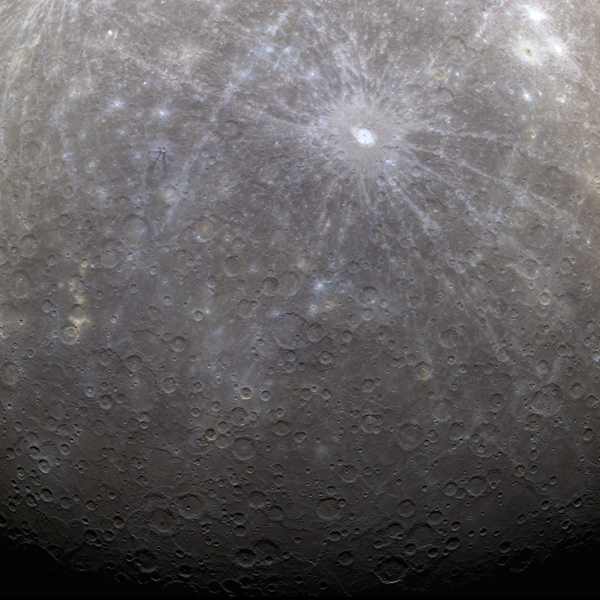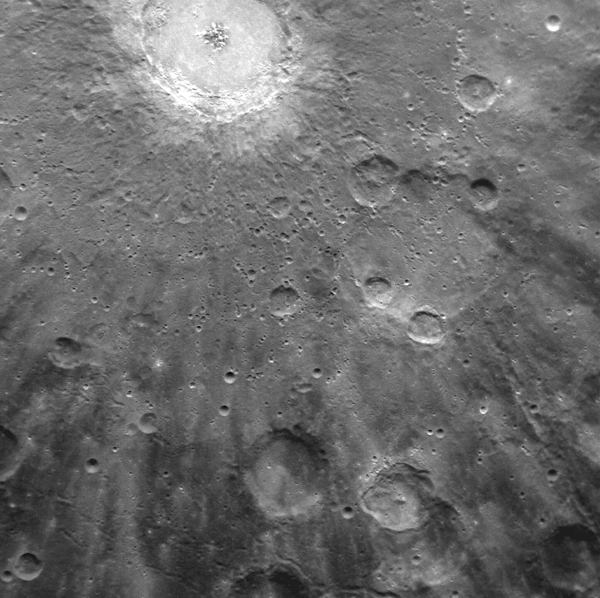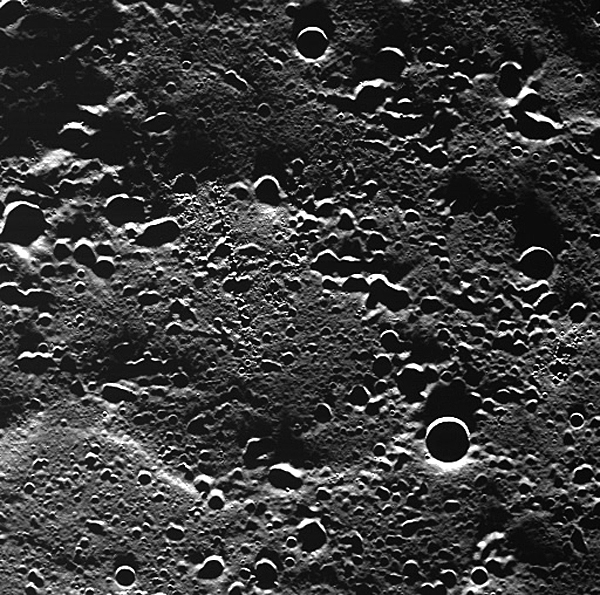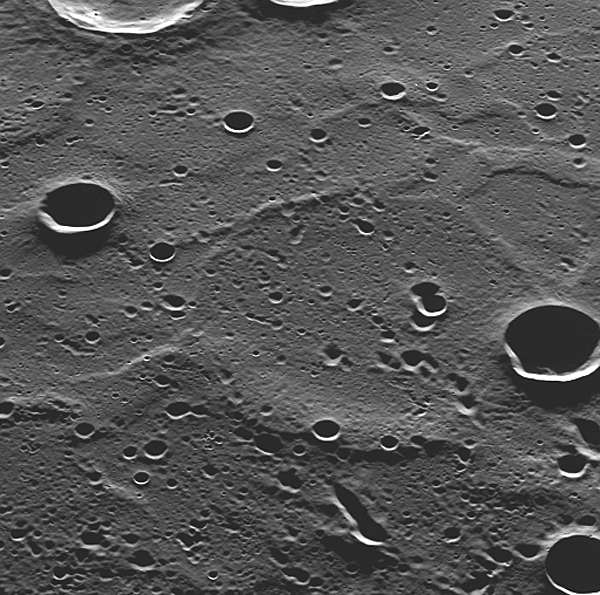MESSENGER pictures of Mercury wow scientists
By WILLIAM HARWOOD
CBS News
Two weeks after braking into orbit around Mercury, NASA's MESSENGER spacecraft is beaming back a steady stream of spectacular pictures, poised to begin a year of detailed observations to map the solar system's innermost world and to help scientists understand its tortured history and evolution.
Built by the Applied Physics Laboratory at Johns Hopkins University, Messenger is the first spacecraft to orbit Mercury, using a near-perfect 15-minute rocket firing March 17 to slow down enough to slip into an elliptical 12-hour orbit with a low point of 128.6 miles and a high point of 9,483 miles.
Throughout its first two dozen orbits, engineers have been activating and checking out the spacecraft's systems and powering up a suite of scientific instruments. Engineers say the craft is operating normally and MESSENGER's cameras are expected to snap more than 1,500 images between Tuesday and Thursday. Full-time mapping operations are scheduled to begin April 4.
"We're really seeing Mercury now with new eyes," Sean Solomon, the MESSENGER principal investigator, told reporters Wednesday. "As a result, an entire global perspective is unfolding and will continue to unfold over the next few months.
"This extremely dynamic planet ... will be on continuous display for the first time (during a period when) solar activity and the interaction between the sun and the planet is ramping up as the solar cycle marches toward maximum. So this is an extremely exciting time to be at Mercury and to watch all of the planetary processes unfold from our ringside perspective."
Among the questions the $446 million Mercury Surface, Space Environment, Geochemistry and Ranging -- MESSENGER -- mission hopes to answer is how Mercury, believed to be 60 percent iron, ended up with an oversize core, a thin shell of a crust and the highest density in the solar system. Scientists also want to understand the composition of the crust, the nature of the planet's magnetic field, its interaction with the sun and whether ice exists in permanently shadowed polar craters.
Solomon said it's too soon to answer any of those big-ticket questions. But he said he's confident the more than 75,000 images and other data expected over the course of MESSENGER's mission will help researchers resolve Mercury's mysteries.
"It's an object that has captivated the imagination and the attention of astronomers for millennia," Solomon said. "It's not the brightest of the (visible) planets, but it holds a special place in the solar system as one of our closest neighbors. ... And we're now there. That point of light in the sky is the object of our study by an observatory that is now orbiting the planet and is about to embark on a year of orbital observations.
"It's just a wonderful thrill to link that not particularly bright dot in the sky with the images we're now seeing, downlinked from the MESSENGER spacecraft, making that link and realizing that we have a robotic presence, a virtual reality, in orbit around that distant point of light. And it is showing an object that has gone through a very complicated geological interior, atmospheric and magnetospheric evolution that parallels that of our own planet. It's just a wonderful adventure for those of us on the science team."
CBS News
Two weeks after braking into orbit around Mercury, NASA's MESSENGER spacecraft is beaming back a steady stream of spectacular pictures, poised to begin a year of detailed observations to map the solar system's innermost world and to help scientists understand its tortured history and evolution.
Built by the Applied Physics Laboratory at Johns Hopkins University, Messenger is the first spacecraft to orbit Mercury, using a near-perfect 15-minute rocket firing March 17 to slow down enough to slip into an elliptical 12-hour orbit with a low point of 128.6 miles and a high point of 9,483 miles.
 |
| The first color image of Mercury shot from orbit by the MESSENGER spacecraft. The bright crater in the upper central region is Debussy, formed by the impact of a large body in the past billion years or so. It appears bright with respect to the surrounding terrain because the relatively young debris blasted out in the impact has not yet been "weathered" by solar particles and radiation. (Credit: NASA) |
Throughout its first two dozen orbits, engineers have been activating and checking out the spacecraft's systems and powering up a suite of scientific instruments. Engineers say the craft is operating normally and MESSENGER's cameras are expected to snap more than 1,500 images between Tuesday and Thursday. Full-time mapping operations are scheduled to begin April 4.
"We're really seeing Mercury now with new eyes," Sean Solomon, the MESSENGER principal investigator, told reporters Wednesday. "As a result, an entire global perspective is unfolding and will continue to unfold over the next few months.
 |
| A closeup of Mercury's Debussy crater and surrounding terrain. (Credit: NASA) |
"This extremely dynamic planet ... will be on continuous display for the first time (during a period when) solar activity and the interaction between the sun and the planet is ramping up as the solar cycle marches toward maximum. So this is an extremely exciting time to be at Mercury and to watch all of the planetary processes unfold from our ringside perspective."
Among the questions the $446 million Mercury Surface, Space Environment, Geochemistry and Ranging -- MESSENGER -- mission hopes to answer is how Mercury, believed to be 60 percent iron, ended up with an oversize core, a thin shell of a crust and the highest density in the solar system. Scientists also want to understand the composition of the crust, the nature of the planet's magnetic field, its interaction with the sun and whether ice exists in permanently shadowed polar craters.
Solomon said it's too soon to answer any of those big-ticket questions. But he said he's confident the more than 75,000 images and other data expected over the course of MESSENGER's mission will help researchers resolve Mercury's mysteries.
"It's an object that has captivated the imagination and the attention of astronomers for millennia," Solomon said. "It's not the brightest of the (visible) planets, but it holds a special place in the solar system as one of our closest neighbors. ... And we're now there. That point of light in the sky is the object of our study by an observatory that is now orbiting the planet and is about to embark on a year of orbital observations.
"It's just a wonderful thrill to link that not particularly bright dot in the sky with the images we're now seeing, downlinked from the MESSENGER spacecraft, making that link and realizing that we have a robotic presence, a virtual reality, in orbit around that distant point of light. And it is showing an object that has gone through a very complicated geological interior, atmospheric and magnetospheric evolution that parallels that of our own planet. It's just a wonderful adventure for those of us on the science team."
 |
| MESSENGER's view of extreme northern terrain showing hundreds of small, secondary craters that were formed by debris blasted out by one or more larger, unseen impactors. (Credit: NASA) |
 |
| Looking south from the north polar region of Mercury, the MESSENGER spacecraft captured this image of deep, shadowed craters and smooth rolling terrain. Permanently shadowed craters near Mercury's poles may harbor ice deposits. (Credit: NASA) |